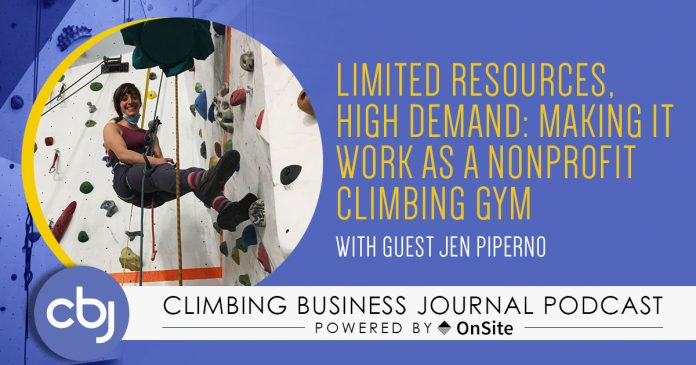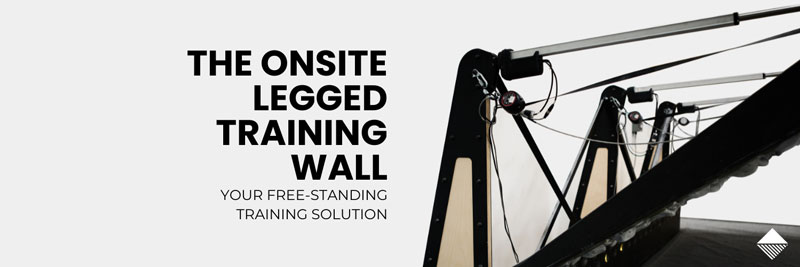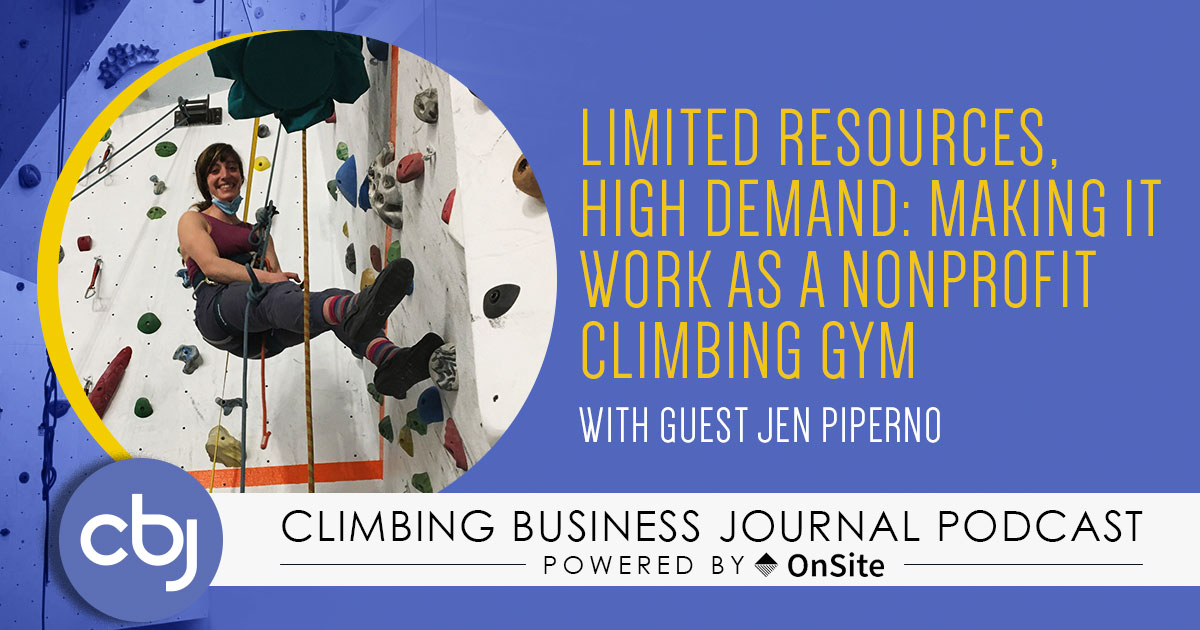
Jen Piperno is the Development Director at Teton Rock Gym in Driggs, Idaho. Teton Rock Gym is unique because it is a 501(c)(3) nonprofit, and that designation frames the gym’s operation, outlook and funding. In this episode, Piperno explains more about what it means for a climbing gym to be a nonprofit business and how such designation can allow a facility to uniquely connect with the local community. Piperno also discusses how her various academic and professional pursuits—including earning a master’s degree in nonprofit management with a concentration in social business—ultimately led to her current distinctive role in the climbing gym industry.
Thank you OnSite for your support!
And thank you Devin Dabney for your music!
Timestamps
00:00 – Intro
02:04 – Piperno’s academic background
06:32 – Piperno’s path to Teton Rock Gym
13:18 – Why the climbing gym as an educational environment?
17:32 – About nonprofits
22:45 – Challenges for the gym
27:50 – Fundraising
31:41 – Competitions
35:55 – Program evaluation
43:05 – Resources for starting a nonprofit
48:40 – Closing
Transcript
BURGMAN: Jen, thank you so much for being on the CBJ podcast today. I would like to start by hearing a little bit more about your background before you started working at Teton Rock Gym. Because from reading up on you a little bit, reading the biography that’s there on the gym’s website, it sounds like you have a very strong interest in and a lot of experience with nonprofit work. So, I guess for starters, what came first, your interest in nonprofit or your interest in climbing?
PIPERNO: My interest in climbing developed much sooner than my interest in nonprofit work. I was exposed to climbing in high school, but I did it very sporadically through a club that I was involved with. And then, as a young adult in my twenties, I became really interested in climbing and climbed super regularly throughout college and did it purely recreationally and socially for a long time before I started to study nonprofit organization and nonprofit management. And that began towards the end of my college career. And then I decided to go to graduate school in my early twenties to learn more about how to run an organization, specifically how to work with people from diverse backgrounds. My master’s program focused on working with international teams. I went to, it’s called SIT Graduate Institute in Brattleboro, Vermont. And the focus was on how to work effectively in multicultural groups with an emphasis on international nonprofit work and social business. So, the melding of my nonprofit education and climbing didn’t happen until March of 2020, when I moved back to Teton Valley when I lost my job in California due to the pandemic.
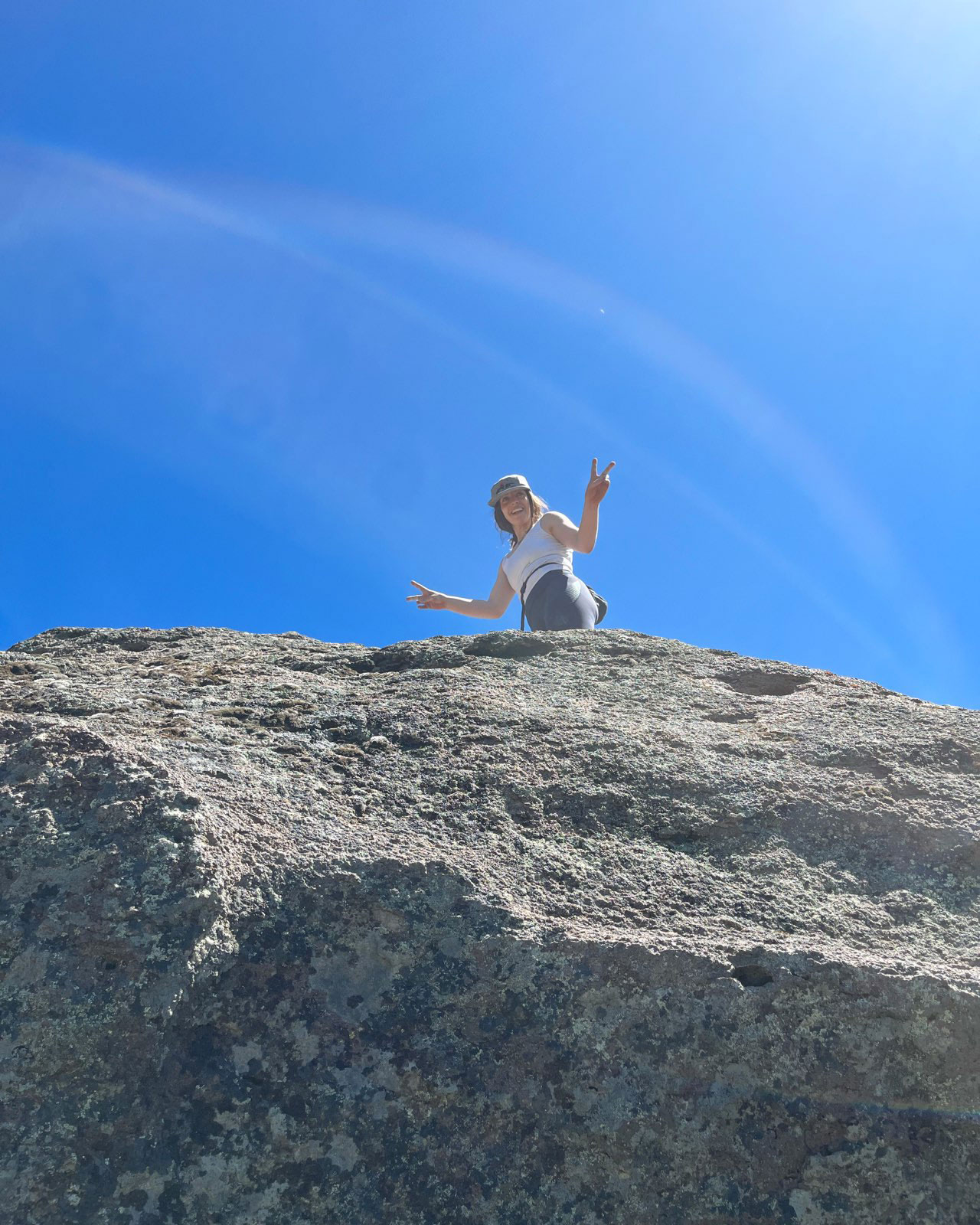
So there’s a lot of good stuff to unpack there. So, when you said that you were doing your academic work and you were focusing kind of on some international stuff, did you have original ambitions of living and working internationally?
I did. So, I’d say that in college I wanted to be a diplomat and spent time after college working in Buenos Aires for the U.S. State Department. I did an internship at the embassy there, which was an attempt to learn more about what that life would look like. And after having that experience, I decided that it was not for me. But I still had a strong interest in working internationally. I’ve traveled a lot in high school. I lived abroad in college; I studied abroad in a number of different countries. And then when I decided to do my graduate work, I wanted to go to a school that really exposed me to people from a lot of different places. And SIT was incredible for that reason. And there are people from all over the world. It was a small cohort of students. I was actually one of the youngest in that program. Many of the individuals enrolled there were coming from places that had experienced a lot of conflict. By that I mean war. So, I think after having the experience in graduate school, I thought that it was important to learn about conflict resolution, conflict transformation, mediation, dialogue training. So, my graduate school work led me in a very circuitous way to education. And in doing so, I learned that—sorry, I got distracted by someone coming in the room. Can you repeat your question for a second? I lost my train of thought.
Yeah, well, I was just saying, you mentioned some of your academic work and some of your experience prior to being a part of the gym entailed international work. And so, I was curious if you originally had ambitions of living internationally, working internationally. And it sounds like there was some of that with your interest in diplomacy and being a diplomat and all of that. And so, I’m just very curious to hear this path of—I’m always curious how people find their way to working at a climbing gym. Because I think probably now, it’s a wonderful thing, there are probably kids that go to the gym that are thinking like, “Yeah, someday when I grow up, I want to work at a climbing gym,” right? But that probably hasn’t been a common thought for a lot of people in the history of the climbing gym world, right? People just kind of, through various means and paths, find their way to working at a climbing gym. So, I’m just interested in hearing kind of how if international diplomacy and all of that is A and B is working at a climbing gym—that long and winding road is really interesting to me.
Super long and winding road [laughs]. I’ll try not to be too long-winded, but long story short [laughs], working, doing my international work, and working with folks from different places, it just led me to believe that being in education was really important, and specifically working with youth was really important. So, I started working with children a couple of years after my graduate school work. And the first context that I really started to work with kids in was at the Teton Science School in Jackson, Wyoming. I worked with their outdoor education program through an AmeriCorps internship. So, I was actually teaching science through their Field Ed department and taking children out into the national park. And that was incredible.
The original intent behind participating in the AmeriCorps program was actually to learn how to manage educators. I really didn’t have an interest in becoming one at the time, but then I fell in love with teaching. I thought that I was good at it, and I fell in love with this place, which is how I first came to be in the Teton area. And then after working there, I went on to work for an organization called the Jackson Hole Children’s Museum. So, I was working with younger students there, and I was exposed to different philosophies of education there, including Reggio Emelia, which is kind of the framework that organization works with. And learned more about teaching, worked very closely with more really seasoned educators there, and was passionate about the work that was happening at that organization.
From there, my partner at the time and I decided to leave Jackson Hole. We moved to New York State, where we both were teachers and faculty at a boarding school for two years. I worked as a kind of assistant director of the library. But I also, as part of my work as faculty there, I had to coach sports. So, I’ve been an athlete my entire life. I played competitive soccer as a youth. I rode horses competitively growing up. So, I was accustomed to and exposed to lots of coaches growing up and to training for sport. So that was my first kind of foray into coaching. I coached the varsity soccer team there as well as the JV basketball team there. And those were sports that I was familiar with growing up. But I loved coaching, even though that was a very secondary part of my job.
That was also where I was exposed to aerial silks for the first time. So, I worked with the member of the faculty there who taught the circus arts program, and I was able to practice silks with her when I was a faculty there and fell in love with silks, which is now something that I teach at the rock gym. So that job provided me a lot in the way of learning new skills for myself but also working with kids through sport. And I was pretty determined to coach children in a way that was different than the way that I was coached as a child.
As a competitive athlete, I had many injuries. I didn’t have a positive relationship with a lot of my coaches. I didn’t have a language to express what I was experiencing in my body. And I just was really determined to coach differently than I was coached. So, I think that was kind of the start of my coaching career, which has now expanded. So, after that position, I went and ran a Pre-K education program and a childcare center that was through a for-profit startup in Los Angeles. So, I was working with about 20 children under the age of five at a for-profit coworking space in L.A. So, I did that for about nine months and lost my job when the pandemic started. And I was seeing someone long distance who ran the Teton Rock Gym here in Driggs. And so, when the pandemic hit, I moved to Driggs. I was looking for work. I had experience with children, I had experience coaching, I had experience with silks, I had experience in managing an organization. And he was pretty desperate for some help. So that is the long-winded story of how I ended up at the rock gym. So started working at Teton Rock Gym in March of 2020.
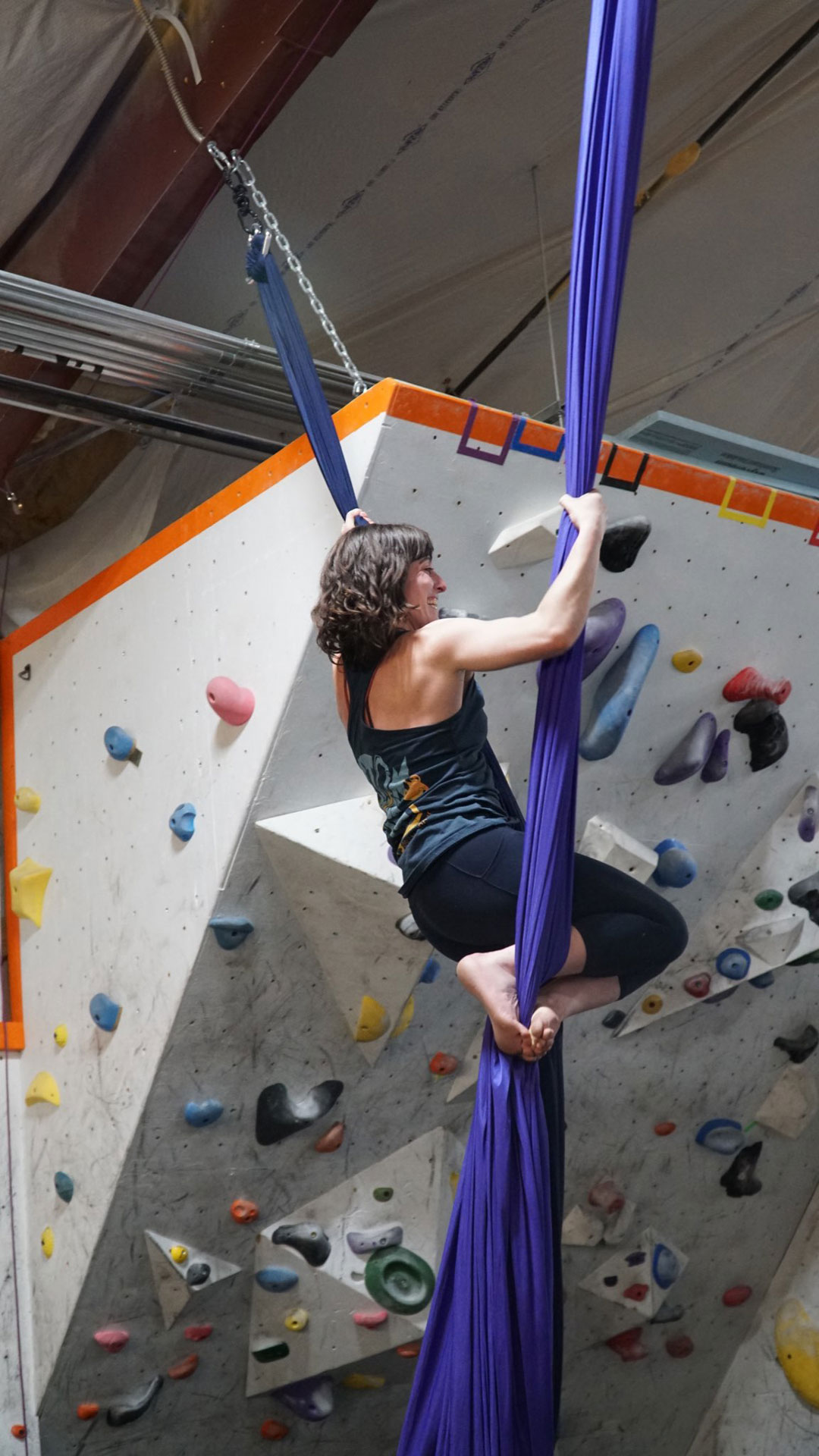
Well, relating to all of that, it sounds like you have a history of being an educator in a number of different environments, maybe even specifically an educator for kids, from classrooms to the children’s museum that you mentioned to like a library context. What is it about a climbing gym—and maybe your gym specifically—what is unique about that as an educational environment for kids compared to any other educational environment that you’ve worked in or taught within?
Yeah, I think our gym is very small. Our gym is about 4,000 square feet. It’s run by myself and my partner Jacob, and we occasionally have seasonal staff, but for the most part, it’s just us. I think we live in a very small community. I think what makes us special is that we know the kids in our community. We work with thousands of children every year. Most of the kids in the community know who we are. And, for example, a lot of the teens have grown up coming through the rock gym, to the point where some of them come to work for us after high school.
I think we’ve created an environment that is safe for kids. It’s a third space for many of them. It’s a place where they can not be at home, not be at school, but feel comfortable socializing with other people. We have an amazing adult community that is more and more starting to interact with our youth climbers in a really positive, beautiful way that I’m really proud of. I think kind of the engagement and the relationships that are forming between youth climbers and the adults that use our space is pretty special, and I haven’t really seen that at other gyms. I think that a lot of kids feel really comfortable being in the space and have become so comfortable that they feel like it’s a second home for them and it’s a place where they can be independent and safe again.
So, I think that our programs, we’ve intentionally kept them pretty small, and as a result, I think the quality of the programs that we run is very high. I think that parents recognize that. We work with the school district as well; I think other teachers in the community see that. I think given our size, the amount of programming that we run for kids is actually pretty impressive. And Jacob and I are very passionate about the youth programs that we run and have done a lot of work to grow them as much as we can, given our capacity as two people. And we’ve done a lot of education to become better coaches and to provide challenges for kids at all levels and with differing abilities, offering pretty inclusive programs for folks, too, with physical disabilities as well as developmental disabilities.
And yeah, again, I think our size and the fact that we’re two regular and committed full-time staff members make us pretty special in an industry where I think a lot of staff are very young or are just looking for memberships or who—it’s a stepping stone to another career, potentially, or another, you know, they’re on break and they want a seasonal job. I think having two full-time, very dedicated staff is really a big differentiator for us. Jacob has been with the gym for about nine years now and helped build the physical facility, so he’s incredibly dedicated to the space.
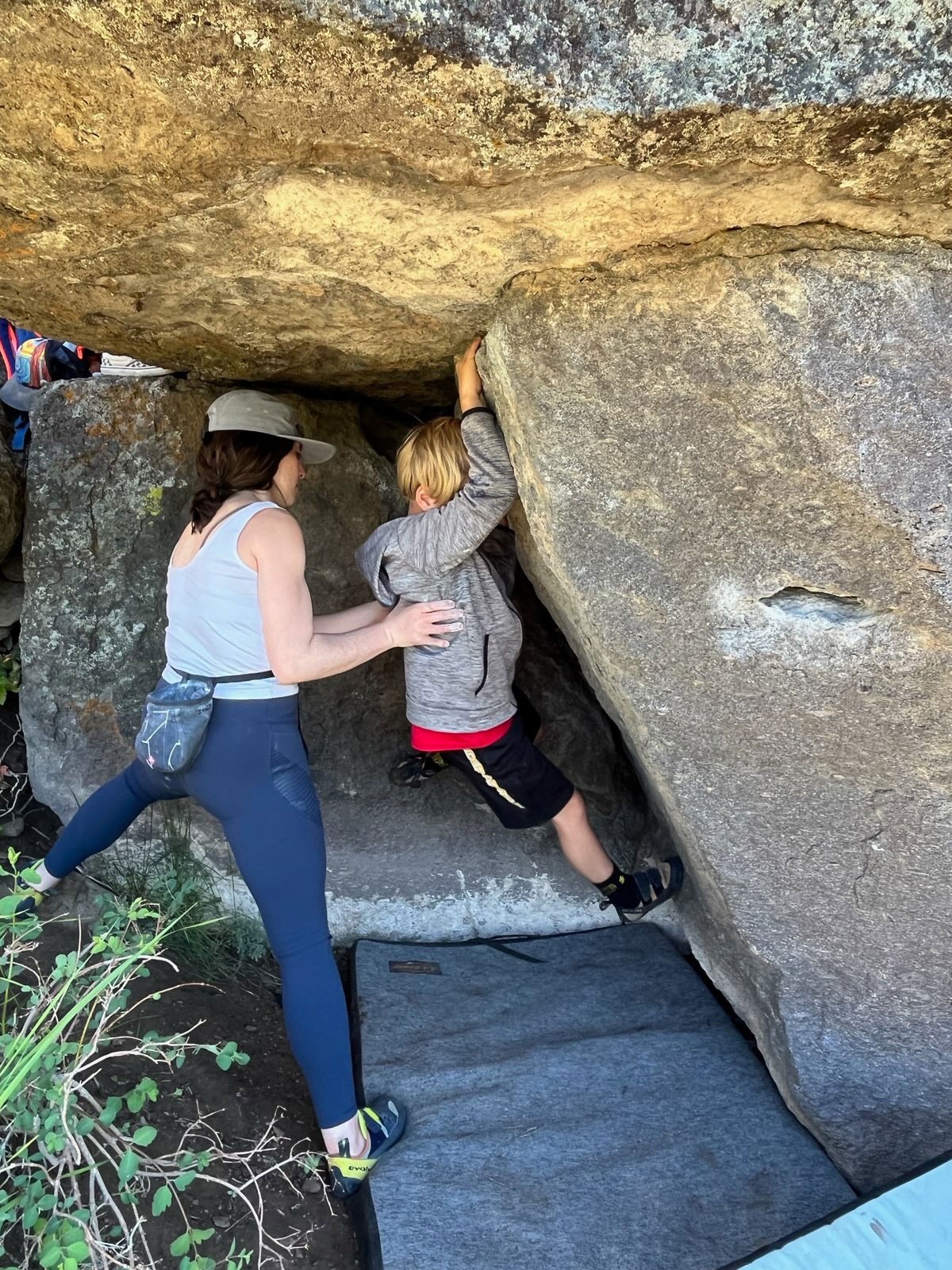
Another thing that is so unique about your gym, unique meaning there aren’t many gyms that are like this, is that it is a nonprofit. And so, I’m curious if you can—well, maybe let’s back up a little bit. Because at the risk of turning this into, like, “Nonprofit 101,” I do think that there’s probably a lot of people listening that maybe know vaguely what nonprofit means. Maybe they have an idea what it means for a business, but maybe not so much what it would mean in the context of a climbing gym. So, can you just explain a little bit about the gym’s nonprofit status, what that means, what it is, what it is not, maybe, and kind of just what all goes into being a nonprofit facility?
Sure. So, when the gym was started, it took a while for it to be incorporated. It was a 501(c)(3) nonprofit. I think it was maybe a year into the project that that status was applied for. It requires paperwork. And it requires the creation of a board of directors. And this was before my involvement with the gym, obviously. But for a number of years, there was an informal, kind of an informal board that eventually grew to—I believe it was seven or eight individuals. Up until this past year, we had about seven or eight board members. Initially, the gym was created by volunteers. It was volunteer-built. It was built with materials salvaged from other gyms. For a number of years, there were no new holds purchased. All the padding was again salvaged from other facilities.
So, the initial cost of starting the rock gym was incredibly low. We were invited into the space that we’re currently in by the City of Driggs, which has created this central space that hosts a number of different organizations, community organizations. Our rent, as a result of our nonprofit status, our rent has been subsidized by the City of Driggs. So, I think that our nonprofit status has afforded us kind of the most important aspect of our organization, which is the physical space. We could not afford to rent a facility in the area that we live in, and we could not afford to build a new facility given the cost of construction here today. So, I think that our advantage as a nonprofit really is in the space more than anything else, the space and the rent that we receive from the city or the subsidized rent that we have as a result.
I think that something that’s important for folks to know is that our organization is different from a lot of nonprofits in the sense that our revenue is what—our revenue, through memberships and programming, is what sustains our daily operations, not fundraising. So, I think in contrary to a lot of other nonprofit organizations who rely exclusively or heavily on raising funds to operate, that is not the case for our organization. So, we’re a bit different than other nonprofits in that sense. So, about 5% of our revenue is fundraising, which is very small.
So, we’ve structured our organization so that our members who pay monthly dues, and our youth programs, and the cost of those programs sustains our organization, not fundraising. So, I think that we’re a bit unique in that sense. Part of that is capacity. So, although I am responsible for raising money for the organization, I am also a full-time coach. I’m also managing the facility, managing any staff we have, and I’m also the headsetter for the organization. So, unlike other nonprofits who have full-time development staff, that is not the case for us. So, I can only dedicate a small amount of my time to actually raising funds. And again, it’s not necessary to spend more time than that, because we’re not relying on fundraising to run our operation.
What are some other challenges, too? Because that’s interesting you mentioned your own personal workload, like just coaching and routesetting. So, time management has to be somewhat of a juggling act at times. But I think a lot of people would hear this, especially here, that the information about the facility being subsidized and all that, and they’d say, “That sounds great,” right? I think every single gym that is listening to this would be enticed by that. I’m sure there is a flip side, challenges that go along with that. Can you highlight or explain some of those challenges?
Challenges are physical space is tight. We have built out our physical facility to pretty much its capacity. If we wanted to do some sort of expansion, we’d have to run a capital campaign. The only kind of room for another large facility upgrade project would be kind of a second-story mezzanine that we’ve flirted with the idea of creating, but that would cost probably over 60+ grand to do that. So that would require a capital campaign if we even got approval from the city to do so. We are on a—so a downside of being in the city building is that we’re on a short-term lease. So even though we were invited to be in the space by the city back in 2013, we have been unable to obtain a long-term lease from the city.
So that, in terms of putting a lot of effort into raising funds, in terms of planning for our capital campaign, we won’t make that move until we have a longer-term lease where we know that we’re not going to lose our space in five to ten years. Because it’s a lot of effort, obviously, and would require a big construction project. So that’s the downside of being where we are, is it’s not our building. And there’s certain modifications, certain improvements, and certain large projects that we wouldn’t be able to do or can’t do, because either we don’t have permission from the city, or we don’t have a long enough lease to commit to doing a project like that. Yeah, those are the biggest downsides, I’d say. That and I think just even though our community is growing, demand for our programs is growing. Eventually I think we might feel more constrained by our physical space. And again, if we ever wanted to move to a new one or buy a new building or build a new building, that would come at such great cost and would require so much fundraising, more than we currently have capacity to do.
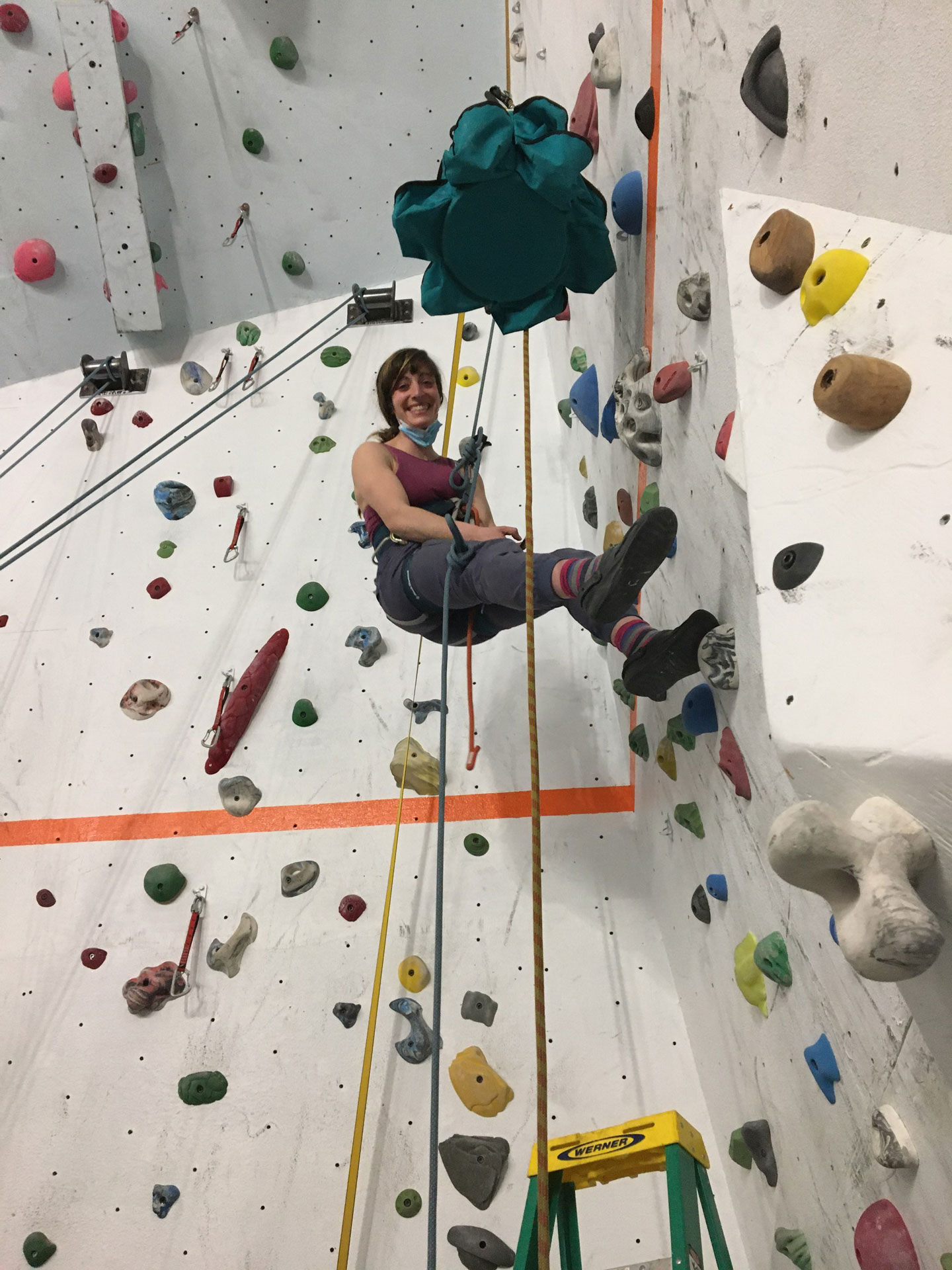
In terms of getting that long-term lease, is it just a matter of—I don’t even know, what would you have to do? Just prove somehow that the community is invested in this space and interested in this space? Or what kind of gamesmanship goes into this situation that you’re in, with wanting and kind of waiting for something longer term?
Yeah, I think that’s the next step. I think we’re starting to kind of embark on that process of kind of soliciting the community for support to make an argument for a longer lease. We haven’t started that process yet, but as we start to do planning with our board—we have a smaller board, so we’ve reduced our board size to three this past year. And that has enabled us to kind of refocus on the work of the gym and the future of the gym. And so those conversations about what we want to do moving forward and what our needs are moving forward, thinking about the space is a big part of that conversation, and how to acquire a longer-term lease so that we could potentially move forward with some expansion plans.
We’re a beloved organization. Again, where we live, we have a very long winter. There are very few indoor recreation spaces for this community. The gym is maybe one of three. And again, we serve a large number of youth and also quite a few adults in this community. Hundreds of adults use our facility and are members in our facility. So, I think that it’s not hard to make the argument for our importance. It’s just a matter of formalizing that and presenting it to the mayor and the other folks in charge of our lease.
I know you said that fundraising isn’t a huge part. You said 5%, I think, is the number that you mentioned. But I am curious, especially since you do have some history in this and some academic interest in it. The 5%, the fundraising that you do at the gym there, what kind of fundraising do you do? What have you found works with that specific community? And maybe if there’s something that doesn’t work. Because fundraising is something that I think any gym, even if a gym is not a nonprofit, obviously there’s always a need for more funding, right? There’s always a need for more money. So, I think any business would be interested in hearing a little bit more about the fundraising that you do.
Yeah. So, every year, Teton Valley, Idaho, through an organization called the Community Foundation of Teton Valley, has a large fundraising event called the Tin Cup Challenge. It’s an organization—excuse me, it’s an event that most nonprofits in Teton Valley participate in. Basically, the community foundation raises funds, and then organizations have about a month or six weeks to raise as much money as they can, and the community foundation will match whatever funds are raised up to a certain percentage. So that is the major annual fundraiser for most organizations in our area. So that’s how we raise the majority of our funds, is through the Tin Cup Campaign. And that happens during the summers. And all the money donated is donated through the community foundation and then dispersed to local organizations who are participating.
So, it’s the Tin Cup Campaign, then historically, we’ve raised funds putting on Reel Rock. The Reel Rock Film Festival has been a fundraiser for us in the past, although we’re going to shift away from that this coming year and just host it as a community event rather than as a fundraiser. We’ve received pretty generous in-kind donations for those events as well. So, a lot of local businesses and larger industry players have given thousands of dollars worth of goods to support those events for us.
We applied to about three local granting institutions annually, and if we’re lucky, we received one or two of those grants. So that’s another way that we’ve funded any major projects that we’ve had at the gym over the years. Those mostly have been funded through grants. So, for example, we received funding for our Moon Board that we have, we’ve received funding to expand our fitness area. We added a kids’ area and a slide a number of years back that was funded by a local granting institution. And this year, we’ve received funding for professional development. So, we’re going to take an SPI this coming year. So, that’s another way we’ve received funding. And those are probably the three. Those are the three main—so, grants, Reel Rock and Tin Cup are the three main fundraising avenues for us.
I can’t help but notice that you didn’t mention comps, competitions. And I think that might surprise some people listening that manage or own gyms. Because I think a lot of gyms think about that as an obvious way to maybe not make a lot of money, but certainly an obvious way to get a lot of people through the door, which could be the first step in getting them to contribute. Yeah. Have you found that comps maybe just don’t, I don’t know, just like don’t bring in that much money or maybe just aren’t kind of a fit for the type of fundraising you want to do? How do you feel about comps?
Comps are fantastic. Comps are also a lot of work, and I’m one person who sets [laughs]. So, I think that comps have been on our radar. We’ve done boulder comps in the past. I think they were pretty successful. Comps stopped for us during COVID, understandably. And again, being two staff doing the setting required for comps has been something that has not been possible for us. And with the schedule that we have too, and the time required. And being a small space, not being able to close or limit people from our gym, we can’t close off one section really to set things like that. And there are more factors that I’ll spare you, but yeah, I’ve also been injured for about a year, so my capacity to set a lot has been limited.
At the moment we are developing a lot of our advanced climbing team to set. They’ve been setting for the last couple of years, and I think they’re at a place now where they can potentially participate in the setting required to run a comp. And they would be excited to do that. So, yeah, it’s about kind of rallying our community to help put on one of those events. But also looking at different types of competitions, too, which is something that we have been thinking about doing and will launch this winter.
So, looking to other formats for comps, maybe not traditional comp style, but more like comps that are ongoing, that don’t require as much input from a setting perspective, that can be weeks-long or months-long events, whether that’s like our, kind of, other east Idaho gyms put on different boulder comps that take place over a number of weeks and don’t require giant resets. And people have teams and things like that. So our, I think it’s Tour de V2 that The Pad does out in California. We’ve just been exploring other formatted comps that would require less input from us over a short period of time. Because again, we’re running programs in our space five days a week and we already work six days a week. So, a lot of it is just a matter of time.
And yeah, I think our community would be really psyched for us to bring competitions back, and we’re excited to try to find ways to do that and to maybe also recruit some setting help from other gyms in our area. Because I know we have two gyms in east Idaho. There’s The Rock Gym – Rexburg and The Edge in Idaho Falls. And they have larger setting teams who might be psyched to help us out, but we’re lucky to be able to participate in those gyms’ comps when they put them on. And we do our best to bring large groups of kids when we can. And our youth teams have started participating in USA Climbing comps this year. So, we’re doing our best to bring our kids and expose our kids to competitions, even though we haven’t put them on ourselves in a number of years.
I want to respect your time, but this does lead into maybe one more question that I have, which is, I know something that your job entails is also program evaluation. And similarly to how you just explained, kind of like the pros and cons of running a comp. When you are evaluating all of the programs that your gym does—and I know your gym, like you said, does a lot of programming, and I know you also work with local schools. And there are, if anybody just thinks about not only comps, but camps and classes and safety courses, there are so many different types of programming that a gym can do. So, when you are evaluating your programs, what is your rubric? What is your criteria that you use to assess whether a program is working, whether it’s hitting the metrics that you want it to hit. What’s your thought process?
Yeah. I think that process isn’t incredibly formalized. Again, we’re two staff, so I feel like we are constantly debriefing programs after almost every class that we coach, whether it’s a local school group or a visiting church group or home school group. So, we’re constantly in touch about the success of our programs. I think a really big indicator of success for us is enrollment. Our programs fill in about 30 seconds [laughs], not to exaggerate. So, there’s a really high demand. We solicit feedback from parents after all of our youth programs. So, I think for us, satisfaction with those programs is gauged in large part from that kind of formal feedback.
After sessions, we often receive requests for types of programming. And I think for the most part, we’ve been able to create programs to satisfy demand. Again, whether it was for adaptive programming, or we’ve been able to incorporate programming for little kids, again, into our community. So, for kids under five, we’re able to offer programming now. I think that because the community is so small—because, again, it’s just two individuals running the gym—when there’s a need, people reach out. And we’ve done a really good job of trying to accommodate for different types of programming. Again, we’re constantly debriefing programming in terms of cost, in terms of time-of-day things are scheduled, in terms of the return. So, if kids are coming back to programs, I’d say the number of kids who are trying to enroll or have enrolled in programs for more than one session is really really high, which indicates to us that we’re doing something right.
Again, parents are upset when they can’t get into our programs, which happens often, so there’s more demand than we can accommodate—just, again, keeping our numbers really low. It’s been a process balancing. So again, we have youth programs, but we also have adult members, and we are in a small space. So, it’s a constant dance for us to satisfy the need for youth programming and to satisfy the adult members of our community who need their own programming. So, I run adult classes as well. So, a soliciting need for not only classes for adults, but events for adults. And we’re often being asked to run different types of educational courses, but also social events for our community. And I think Jacob and I are really receptive to trying new things.
I think our community is interesting in that, not only is it a small community, but launching new programs can be a really interesting process that can take months before any momentum is gathered. I think having the patience to receive requests for programming and then continuing with a program that might not seem, on its face, successful right away because maybe low enrollment or low attendance. But what I’ve realized is that you have to continually offer something for a while before people understand that it’s a regular thing, it’s on their radar. Consistency in terms of time and date is pretty important in this community. I think a takeaway that we’ve learned is that people need to know that something is happening regularly before they’ll show up.
So I think that metric for us is not just attendance, even though that might seem like the really obvious metric, but just trying to provide really high-quality experiences, even if there’s only one or two people, because eventually those numbers will grow. And that’s been most obvious with a Women’s Climb Night event that I’ve put on for the past couple of years, which for many months was two, three, four people and is now consistently over 20 attendees, which for our community is really small. And I’ve lived in bigger places as well; I’ve lived in Los Angeles, I’ve lived in New York City. I’ve attended many Women’s Climb Nights at other much bigger facilities with much lower attendance than that. So I think the metrics are different depending on the program, honestly.
We work with lots of different demographics. We run outdoor programs as well as indoor programs too, and the metrics for those are different as well. So, I don’t know, I can keep babbling on, but I think it’s complex. And I think our community is pretty unique in its size, specifically when it comes to programming and limited offerings for youth and limited offerings for adults as well. So, trying to kind of navigate needs is constantly challenging, given our size as an organization.
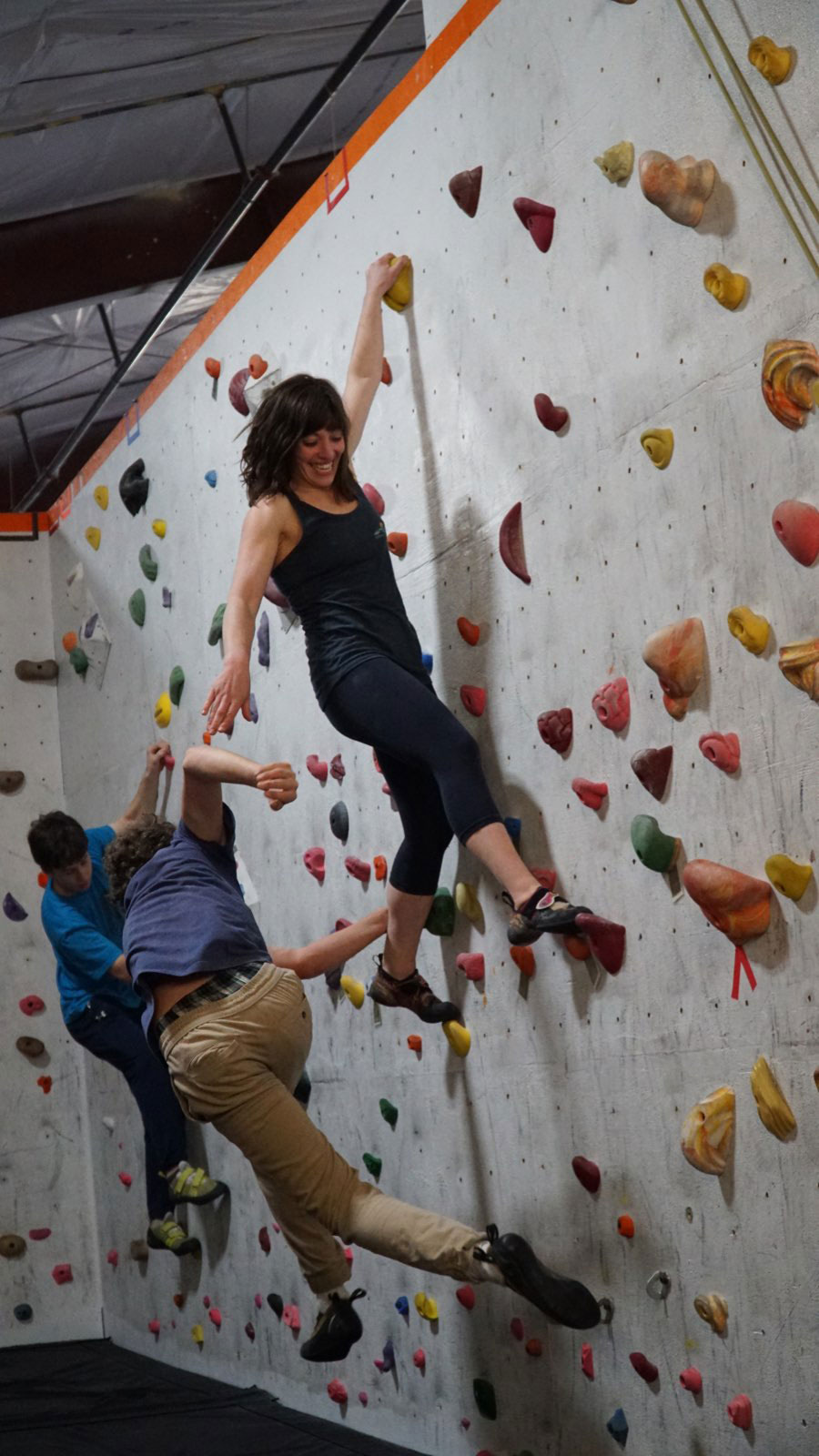
This has been really informative. I think a lot of people will go into this seeing that Teton Rock Gym is a nonprofit and there will be some curiosity and “how does a nonprofit gym work?” And so, I appreciate you sharing some insights, sharing some of your experience. Is there, like, I don’t know, a good starting place if people are listening to this and they want to know more about running a nonprofit business? I know there are thousands of books, and I’m sure there’s thousands or even tens of thousands of YouTube videos and all that. If somebody’s just listening, can you recommend where they should start to learn more if this podcast has caused a spark for somebody?
Sure. I think BoardSource is a really good resource for nonprofit organizations. I think, honestly, one of the biggest challenges of nonprofit work is the board of directors. And I would recommend learning about boards, about board structure and about managing boards. And I think that, for us, a big takeaway for us is that less is more. Again, there are different types of boards, fundraising boards, governance boards. Again, for us, because of the way we’re structured, because of our finance structure, and how our revenue is predominantly from memberships and programs versus fundraising, I think we’ve been on a seven-year journey to kind of understand the role that our board has to play and needs to play for our organization.
So I think that there’s a lot of information about nonprofit organizations, a lot of it that doesn’t really apply to us, which is something that we’ve had to learn over time—that given our size, a lot of the formal processes that are often considered to be really essential if you take any course on strategic planning or organizational management, when you are only two people, a lot of those formal structures don’t really serve us. And that’s been a really big point of learning, because I think if there’s other community foundations similar to the one that we have, again, there’s a lot of formal jargon. There’s a lot of things that are considered normal for a nonprofit organization that in reality are either not helpful, like detract from the actual work, especially when you have limited capacity.
And, yeah, I would just recommend to anyone listening that if you’re starting small, just understanding that the role of the board should really be to support the staff, and that ideally the staff is entrusted to run the organization and have the best interest of the organization at heart, and that if your board is creating more work for staff, then that’s not helpful for anyone. So, I think that understanding board roles and responsibilities, and also minding the gap between kind of the academic, nonprofit world and all that is touted as being essential and important with the actual reality on the ground of essentially running a business. And I think that that’s—I think our biggest learning in the last eight years as an organization is just learning to identify what’s important. And for us, that’s community and creating a safe space.
And really, that is why we do what we do. And that is, whether it’s a climbing gym or any other type of nonprofit, like working with people. I think that you don’t need 50-page employee pamphlets. You need to find ways to realistically just support the people who are supporting the community. So, I don’t know. I apologize, that is not very succinct or clear, but I think that our nonprofit status is just a number, right? It applies to taxes and things like that. But yeah, I think if people think that incorporating as a nonprofit makes anything easier, I think that’s a false idea. So, essentially, we run a business. And, yeah, it’s really not that different.
It sounds like a really special place. It sounds like it’s really connecting with the community and especially a lot of the kids there. But of course the adults, too. As you mentioned, there’s a vibrant community of adults, vibrant community of kids, all coming together at your gym. It sounds like a really cool place, and I’ve enjoyed getting to learn about it a little bit. Thank you so much for being here. I really appreciate it.
Thanks, John. I appreciate you reaching out.

John Burgman is the author of High Drama, a book that chronicles the history of American competition climbing. He is a Fulbright journalism grant recipient and a former magazine editor. He holds a master’s degree from New York University and bachelor’s degree from Miami University. In addition to writing, he coaches a youth bouldering team. Follow him on Twitter @John_Burgman and Instagram @jbclimbs. Read our interview Meet John Burgman, U.S. Comp Climbing’s Top Journalist.



